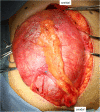Giant multilocular prostatic cystadenoma
- PMID: 30808350
- PMCID: PMC6391754
- DOI: 10.1186/s12957-019-1579-7
Giant multilocular prostatic cystadenoma
Abstract
Background: The giant multilocular prostatic cystadenoma is a very rare benign tumor of the prostate gland. It is composed of predominantly cystic enlarged prostatic glands in a fibrous stroma and spreads extensively into the pelvis. Because of the large size at the time of diagnosis, it is not always possible to determine the exact point of origin for these multilocular cystic neoplasms. Thus, diagnosis before histological examination of a surgical specimen is often difficult. Here, we present a case involving one of the largest giant multilocular prostatic cystadenomas reported in the literature and discuss preoperative diagnoses and appropriate surgical approaches for this rare retroperitoneal tumor.
Case presentation: A 50-year-old man presented with a 2-year history of abdominal distension and lower urinary symptoms. Enhanced CT showed a large retroperitoneal mass with multiple septations in the pelvis and lower abdomen, measuring 30 cm in size, surrounding the rectum and displacing the bladder, prostate, and seminal vesicle to the right anterior side. MRI showed multiple cysts with a simple fluid appearance on T2-weighted images and enhanced solid components on gadolinium-enhanced fat-saturated T1-weighted images, suggesting the retroperitoneal mass as leiomyoma with cystic degeneration or perivascular epithelioid cell tumor. Biopsy of the mass showed a spindle cell tumor with focal smooth muscle differentiation. Differential diagnosis comprising leiomyoma, low-grade leiomyosarcoma, and perivascular epithelioid cell tumor was made. Complete resection of the tumor with low anterior resection of the rectum was performed. The tumor was solid with multilocular cavities containing blackish-brown fluid and measured 33 × 23 × 10 cm. Histologically, the tumor was composed of variously sized dilated glandular structures lined by prostatic epithelia surrounded by fibromuscular stroma. The prostatic nature of the lesions was confirmed by immunohistochemical staining of the epithelium for prostate-specific antigen. Thus, pathological diagnosis was a giant multilocular prostatic cystadenoma.
Conclusions: We present our experiences with one of the largest giant multilocular prostatic cystadenomas. When a retroperitoneal huge lesion with locular cavities fills the pelvis in a male patient, the possibility of giant multilocular prostatic cystadenoma should be considered before planning for retroperitoneal tumor treatment.
Keywords: Giant multilocular prostatic cystadenoma; Prostatic tumor; Retroperitoneal tumor.
Conflict of interest statement
Ethics approval and consent to participate
Ethics approval was obtained from our hospital’s review board (NCC2017-437).
Consent for publication
Written informed consent was obtained from the patient.
Competing interests
The authors declare that they have no competing interests.
Publisher’s Note
Springer Nature remains neutral with regard to jurisdictional claims in published maps and institutional affiliations.
Figures





References
Publication types
MeSH terms
LinkOut - more resources
Full Text Sources
Medical

